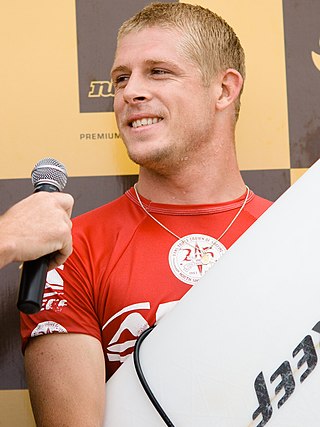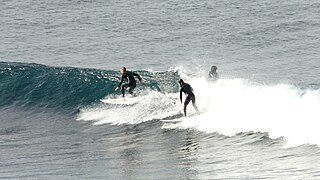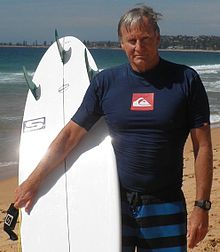
Surfing is a surface water sport in which an individual, a surfer, uses a board to ride on the forward section, or face, of a moving wave of water, which usually carries the surfer towards the shore. Waves suitable for surfing are primarily found on ocean shores, but can also be found in standing waves in the open ocean, in lakes, in rivers in the form of a tidal bore, or in wave pools.

A surfboard is a narrow plank used in surfing. Surfboards are relatively light, but are strong enough to support an individual standing on them while riding an ocean wave. They were invented in ancient Hawaii, where they were known as papa he'e nalu in the Hawaiian language, and were usually made of wood from local trees, such as koa. They were often over 460 cm (15 ft) in length and extremely heavy. Major advances over the years include the addition of one or more fins (skegs) on the bottom rear of the board to improve directional stability, and numerous improvements in materials and shape.
Mark Richards, known as MR, is an Australian surfer who became a four-time world champion (1979–1982).

Robert Kelly Slater is an American professional surfer, best known for being crowned World Surf League champion a record 11 times. Slater is widely regarded as the greatest professional surfer of all time, and holds 56 Championship Tour victories. Slater is also the oldest surfer still active on the World Surf League, winning his 8th Billabong Pipeline Masters title at age 49.

George Hamilton Perkins Greenough is an influential surfer, known during the 1960s and 1970s for his work in film, and in surfboard design, fin characteristics, and other creations for the aquatic medium. The contributions of Greenough, along with Bob McTavish, to the development of short boards resulted in a number advances in surfboard shaping and other surfing technology.
Gerry Lopez, aka Mr. Pipeline, is an American surfer, shaper, journalist and film actor.
Michael "MP" Peterson was a professional Australian surfer. He was considered one of the best surfers in Australia during the early to mid-1970s and was recognised for his deep tube riding skill, especially at Kirra on the Gold Coast, Australia. Peterson was the Australian champion in the years 1972 and 1974, and won many other major surfing competitions. Peterson was eventually diagnosed with schizophrenia and became publicly known for using illicit drugs.

The riding of waves has likely existed since humans began swimming in the ocean. In this sense, bodysurfing is the oldest type of wave-catching. Undoubtedly ancient sailors learned how to ride wave energy on many styles of early boats. Archaeological evidence even suggests that ancient cultures of Peru surfed on reed watercraft for fishing and recreation up to five thousand years ago. However, standing up on what is now called a surfboard is a relatively recent innovation developed by the Polynesians. The influences for modern surfing can be directly traced to the surfers of pre-contact Hawaii.

A surfboard shaper is someone who designs and builds surfboards. The process of surfboard shaping has evolved over the years, and the shaper often tailors his or her work to meet the requirements of a client or a certain wave. Surfboard shapers can be independent or work in collaboration with mass-production companies.

Michael Eugene Fanning is an Australian professional surfer who was crowned champion of the Association of Surfing Professionals/World Surf League (ASP/WSL)'s World Tour in 2007, 2009 and 2013. In 2015, he survived a shark attack by what is suspected to be a great white shark during the J-Bay Open finals in Jeffreys Bay.
Piping Hot is an Australian surf and street clothing brand. It was established in 1975 by Fred Pyke and Rod Brooks in Torquay, Victoria.

A surfboard fin or skeg is a hydrofoil mounted at the tail of a surfboard or similar board to improve directional stability and control through foot-steering. Fins can provide lateral lift opposed to the water and stabilize the board's trajectory, allowing the surfer to control direction by varying their side-to-side weight distribution. The introduction of fins in the 1930s revolutionized surfing and board design. Surfboard fins may be arrayed in different numbers and configurations, and many different shapes, sizes, and materials are and have been made and used.

This glossary of surfing includes some of the extensive vocabulary used to describe various aspects of the sport of surfing as described in literature on the subject.[a][b] In some cases terms have spread to a wider cultural use. These terms were originally coined by people who were directly involved in the sport of surfing.
Sean Mattison is an American former professional surfer and current professional surf coach, known mostly for designing "The Nubster", a fifth surfboard fin. Mattison is also the designer of his own alternative high performance surfboards and surfboard fins named Von-Sol.

Australia is renowned as one of the world's premier surfing destinations. Surfing underpins an important part of the Australian coastal fabric. It forms part of a lifestyle in which millions participate and which millions more have an interest. Australian surfboard-makers have driven innovation in surfboard design and production since the mid-1960s. The country has launched corporate giants such as Billabong, Rip Curl and Quiksilver.
Donald Moke Takayama was an American professional surfer and surfboard shaper. Originally a longboard surfer, Takayama won the Master's division of the United States Surfing Champions in 1971, 1972 and 1973. Hawaiian born, Takayama learned to surf at Waikiki Beach and moved to California in the mid-1950s. Takayama died of complications from heart surgery; he is survived by his wife and four daughters.
Chris Christenson is an American surfboard shaper, craftsman, and outdoor enthusiast.
Christo Hall is an entrepreneur, ex-professional surfer, author and owner of a marketing agency.

Haydenshapes Surfboards is an Australian based performance surfboard brand founded by Hayden Cox in 1996. Haydenshapes' most notable design is the Hypto Krypto model. The brand is known for their use of parabolic carbon fibre frame surfboard technology FutureFlex. The Haydenshapes has a team of professional athletes that includes free surfer Craig Anderson (Quiksilver) and surfer Creed Mctaggart (Billabong).











